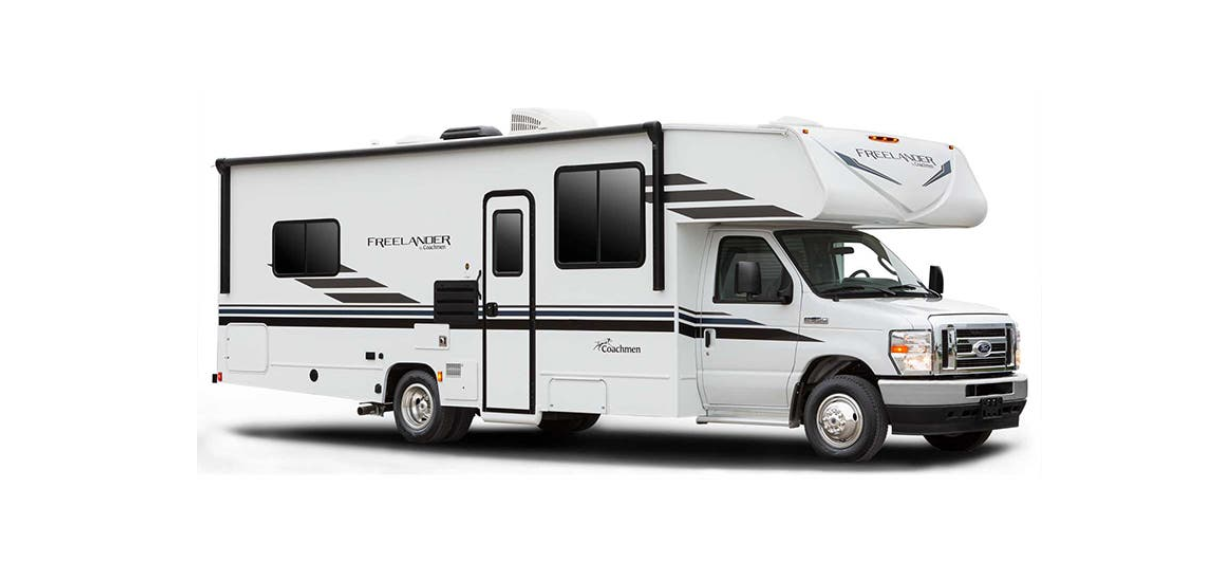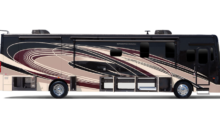2022 Coachmen Freelander CLASS C MOTORHOMES Propane Overview Owners Manual




2022 Coachmen Freelander CLASS C MOTORHOMES Propane Overview


Propane Overview
The amount of propane remaining in the propane tank can be monitored by pressing the appropriate monitor buttons on the monitor panel or main multiplex system panel (if equipped).
Since the propane tank is permanently mounted to the frame, the motorhome must be taken to a propane dealership for filling. Do not attempt to remove the propane tank from the vehicle. The tank is equipped with a fill adapter with both internal and external threads, which allows easy filling with any propane filling equipment. The tank is full when liquid propane gas appears at the overflow valve. New propane containers are filled with inert gas, which must be carefully purged before filling with propane.
The propane is stored with extreme pressure in the tank with space in the tank to allow for expansion into vapor. This vapor is reduced in pressure by passing through a regulator. This reduction in pressure is a two-step process that ensures consistent pressure for use, regardless of outside temperatures, weather, or altitude.
The following warnings are posted throughout your recreational vehicle to provide information on propane safety They have been installed not only because of the requirement to do so but also as a constant reminder to occupants of the recreational vehicle to exercise proper caution when using or being around propane appliances and equipment. We are listing them here so you may study them and be sure that you and your family understand and follow them.
WARNING
- Gas cooking appliances need fresh air for safe operation. Before operating, open vents or windows slightly or turn ON the exhaust fan prior to using cooking appliances. Gas flames consume oxygen, which should be replaced to ensure proper combustion. Improper use may result in death or serious injury.
- When using this outdoor cooking area the vehicle must be level and stabilized. Do NOT violate manufacturers’ instructions on required clearances for cooking appliances during use. Do NOT store cooking appliances until cool to the touch. Can lead to a fire and explosion and result in death or serious injury.
- Do NOT fill propane container(s) to more than 80 percent of capacity. A properly filled container contains approximately 80 percent of its volume as liquid propane. Overfilling the propane container(s) can result in uncontrolled propane flow, which could lead to a fire or explosion and result in death or serious injury.
- Do NOT place propane containers inside the vehicle. Propane containers are equipped with safety devices that relieve excess pressure by discharging propane to the atmosphere. Propane gas is highly flammable. Can lead to a fire or explosion and result in death or serious injury.
- This propane piping system is designed for use with propane ONLY. Do NOT connect natural gas to this system. Securely cap inlet when not connected for use. After turning on propane, except after normal cylinder replacement, test propane piping and connections to appliances for leakage with soapy water or bubble solution Do not use products that contain ammonia or chlorine to test for leaks. May lead to a fire or explosion, which could result in death or serious injury.
- ALWAYS have an authorized propane supplier fill your propane tanks. When the propane container is being filled, Do NOT smoke, strike a match or ignite a lighter. A spark or flame could ignite fumes. Also, be sure all burner and pilot flames are extinguished and the supply valve is CLOSED.
- If you detect sulfur or ‘rotten egg’ odor, Do NOT turn on any appliances. Shut off all operating appliances. Extinguish any open flames, including cigarettes. Do NOT touch any electrical switches. Open windows and doors and exit the vehicle. Shut off the propane.
- To avoid possible problems, have your propane system checked at least once a year by an authorized service center and after each extended trip.
- NEVER test for a leak by lighting a match or having an open flame where you suspect a leak. Take to an authorized service center.
DANGER
NEVER use any other type of propane container than the one furnished with your RV. If the tank must be replaced, check with your dealer for specifications. Propane regulators must ALWAYS be installed with the regulator vent facing downward. Regulators that are not in compartments have been equipped with a protective cover. Be sure the regulator cover is kept in place to minimize vent blockage that could result in excessive propane pressure, causing fire or explosion.
IF YOU SMELL PROPANE:
1. Extinguish any open flames and all smoking materials.
2. Shut OFF the propane supply at the container valve(s) or propane supply connection.
3. Do NOT touch electrical switches.
4. Open doors and other ventilating openings.
5. Leave the area until the odor clears.
6. Have the propane system checked and the leakage source corrected before using it again.
Ignition of flammable vapors could lead to a fire or explosion and result in death or serious injury. Do NOT use gas cooking appliances for comfort heating. May lead to carbon monoxide poisoning, which can lead to death or serious injury. All pilot lights, appliances, and igniters (see operating instructions) shall be turned OFF before refueling of motor fuel tanks and or propane containers. May cause ignition of flammable vapors, which can lead to a fire or explosion and result in death or serious injury. Do NOT attempt to make repairs to the propane system or appliances except for simple maintenance and occasional tightening of a connection. ALWAYS take your vehicle to an authorized dealer for propane problems. Do NOT turn on the propane supply if you smell or suspect that there is a leak.
Recent Posts
VW Jetta Engine Fuse Box Diagram
Access the comprehensive 2010-2018 VW Jetta Passenger Fuse Box Diagram to troubleshoot electrical issues effectively.…
VW Jetta Passenger Fuse Box Diagram
Explore the comprehensive VW Jetta Passenger Fuse Box Diagram to troubleshoot electrical issues effectively. Understand…
2023 Ford F-150 Lightning Fuse Box Diagram
Under Hood Fuse Box Location Remove the front luggage compartment cover. Under Hood Fuse Box…
2022 Kawasaki NINJA H2 SX SE Brake Lever Adjuster Owner’s Manual
2022 Kawasaki NINJA H2 SX SE Brake Lever Adjuster Owner's Manual NOTICE Only adjust the front…
2023 Land Rover Range Rover Evoque Exiting The Vehicle Owners Manual
2023 Land Rover Range Rover Evoque Exiting The Vehicle SINGLE LOCKING WARNING Before exiting the…
2023 Land Rover Range Rover Evoque Front Seats Owners Manual
2023 Land Rover Range Rover Evoque Front Seats FRONT SEAT SAFETY Make sure to read…


